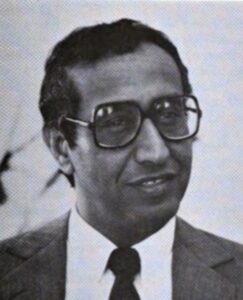
The namesake of the school, Sharif Abd Al Hamid Sharaf (1939-1980) was a member of the Hashemite family and a cousin to the royal families of Jordan and Iraq. He was the youngest child of Sharif Sharaf bin Rajeh (1880-1955), who was the last Hashemite emir of Taif before the House of Saud took control of the Hejaz in 1925. Abd Al Hamid Sharaf’s father joined his Hashemite cousins (Sharif Hussein bin Ali – the Sharif of Mecca, King of Hejaz, and patriarch of Jordan’s and Iraq’s kings – and his sons Ali, Abdallah, Faisal, and Zeid), who had led the Great Arab Revolt (1916-1918) against the Ottoman Empire during WWI. After 1925, Sharif Sharaf bin Rajeh and his family re-located to Iraq where Abd Al Hamid Sharaf was born.
Abd Al Hamid Sharaf was two years of age when political turmoil resulted in his family’s expulsion from Iraq in 1941. The family eventually found refuge in Jordan at the invitation of King Abdallah I, where he grew up and his father Sharaf bin Rajeh was a member of the Jordanian Senate from 1950-1955.

In 1955 at the age of 16, Abd Al Hamid Sharaf was the youngest freshman (that year) at the American University of Beirut (AUB). There, he met his future wife, Leila Najjar Sharaf, as fellow student activist in the Movement of Arab Nationalists. He completed his studies at AUB with a BA in Philosophy (1959) and an MA in International Relations (1962). He later continued Doctoral studies in Political Science at Georgetown University, Washington, DC.
Sharif Abd Al Hamid Sharaf was a progressive intellectual, a career diplomat, and Pan-Arab statesman, who in 1961, began his service to Jordan by working in the Foreign Ministry. He served in various posts and by 1965 was appointed Minister of Information and Culture in the cabinet of Prime Minister Wasfi Al Tal.
After the six-day war in 1967, His Majesty King Hussein assigned Abd Al Hamid Sharaf to serve Jordan as Ambassador to the United States and Canada, and to the United Nations in 1972. He was recalled to Jordan by King Hussein in 1976 to become head of the royal court (Diwan) and his close chief advisor. In late 1979, King Hussein called on him to be Prime Minister. His untimely death of a heart attack just over six months later was a national tragedy that shook King Hussein and everybody in Jordan.
Abd Al Hamid Sharaf was popular and dynamic, with a wide-ranging progressive agenda that included reforming the educational system, conservation, and promoting women’s rights. In fact, his cabinet was the first to include a female minister in Jordan. He had created the ministry of Social Development and chose Ina’am Qaddoura Al Mufti to be its first minister.
AHSS honors Abd Al Hamid Sharaf’s memory and legacy. The school’s philosophy shares many of his ideas, including the director’s open-door style, and the promotion of individuality and self-responsibility. Abd Al Hamid Sharaf was a great complement to His Majesty King Hussein’s vision for Jordan’s modern development.
Seale, Patrick (1983). The Shaping of an Arab statesman Sharif Abd al-Hamid Sharaf and the modern Arab world. London Quartet Books
https://arabrevolt.jo/en/heros-list/sharif-sharaf-bin-rajeh/




Abdul Hamid Sharaf School (founded in 1980) is among the first private, coeducational, non-parochial, K-12 day schools in Amman, Jordan. It serves the needs of a diverse group of students, international and local.
Shuhadaa Amman Street
Deir Ghbar, Al Diyar
P.O. Box: 6008
Amman 11118, JO
Tel: +962 6 5924 188
Fax: +962 6 5924 623
E-mail: ahss@ahss.edu.jo